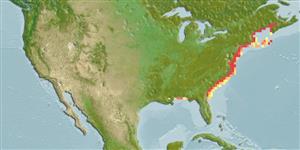Common names from other countries
Environment: milieu / climate zone / depth range / distribution range
Écologie
; profondeur 0 - 36 m (Ref. 83435). Subtropical, preferred 17°C (Ref. 107945); 49°N - 30°N, 80°E - 65°W (Ref. 83435)
Atlantic and the Mediterranean.
Length at first maturity / Taille / Poids / Âge
Maturity: Lm ? range ? - ? cm Max length : 13.0 cm TL mâle / non sexé; (Ref. 7726); âge max. reporté: 9 années (Ref. 2823)
Maximum depth from Ref. 104365. Found buried in muddy sediment on the lower shore and shallow sublittoral and in bays and estuaries. Prefers sandy environments to depths of 15 m (Ref. 78574).
Life cycle and mating behavior
Maturité | Reproduction | Frai | Œufs | Fécondité | Larves
Members of the class Bivalvia are mostly gonochoric, some are protandric hermaphrodites. Life cycle: Embryos develop into free-swimming trocophore larvae, succeeded by the bivalve veliger, resembling a miniature clam.
Harvey-Clark, C. 1997. (Ref. 7726)
Statut dans la liste rouge de l'IUCN (Ref. 130435)
statut CITES (Ref. 108899)
Not Evaluated
Not Evaluated
Utilisations par l'homme
Pêcheries: commercial
FAO - Aquaculture: production, species profile; pêcheries: landings, species profile | FishSource | Sea Around Us
Outils
Sources Internet
Estimates based on models
Preferred temperature
(Ref.
115969): 8.8 - 23.7, mean 13.2 (based on 120 cells).
Résilience
Haut, temps minimum de doublement de population inférieur à 15 mois (K=0.16-0.5; tmax=9).
Prior r = 0.43, 95% CL = 0.28 - 0.65, Based on 3 data-limited stock assessments.
Vulnérabilité
Low to moderate vulnerability (25 of 100).
